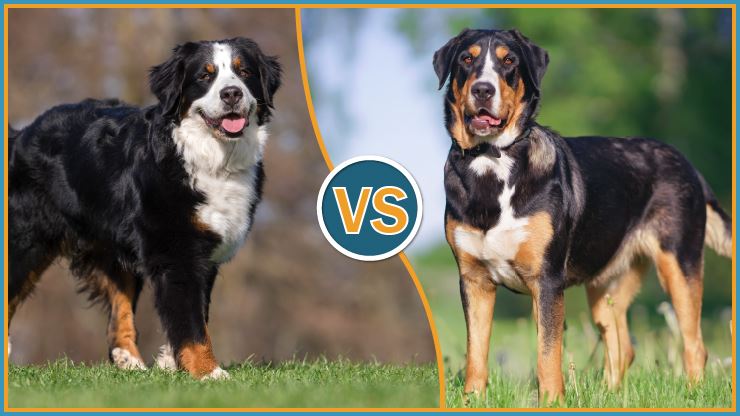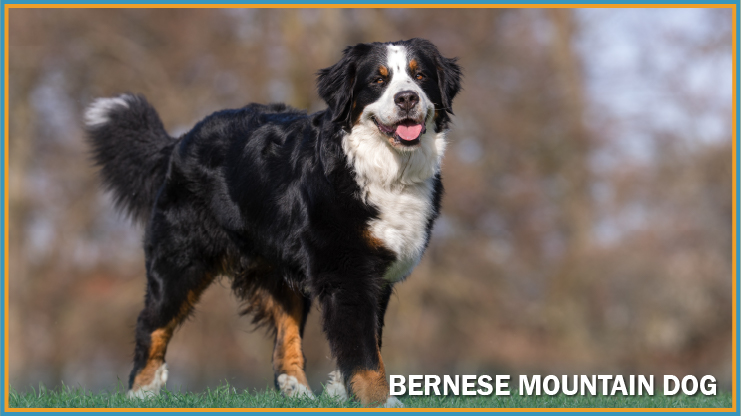
BERNESE MOUNTAIN DOG VS. GREATER SWISS MOUNTAIN DOG: CAN YOU TELL THEM APART?
In the last blog, we discussed the German Shepherd vs. the Belgian Malinois. This time, we will consider the similarities and differences between the Bernese Mountain Dog and the Greater Swiss Mountain Dog. Let’s take a look!
Brief History of the Bernese Mountain Dog
The Bernese Mountain Dog is one of the four tricolored Swiss mountain dog family members, including the Appenzeller Sennenhund, the Entlebucher Mountain Dog, and the Greater Swiss Mountain Dog. The Swiss Mountain dogs were historically used as all-purpose farm dogs, assisting their families by driving livestock, carting milk wagons, and guarding property and livestock. The Bernese Mountain Dog was believed to have been created when some native Swiss mountain farm dogs were crossed to large ancient Roman military dogs brought to the area during the Roman invasion of Helvetia (modern-day Switzerland) some 2000 years ago. The cross resulted in large dogs of great strength and endurance. They were best known for their carting abilities, described by some as the Clydesdales of the dog world.
Originally called the Durbacher, named after a district in which their ancestors were most abundant and favored, the Bernese Mountain Dog has a rich history. Also known as the Berner Sennenhunde, which in German translates to “Mountain Pasture dog of Berne,” they eventually became known for the Canton of Berne, a district in Switzerland where the breed originated.

The Bernese Mountain Dog was once plentiful in their homeland. Still, due to a lack of formal breeding programs and changes in agriculture technology, the breed’s popularity began to wane until it nearly disappeared in the mid-nineteenth century. However, thanks to Swiss cynologist Herr Franz Schertenleib and Professor Albert Heim, the breed was brought back from the brink of extinction. The Bernese Mountain Dog’s popularity slowly began to increase. By the early twentieth century, farmers from around the land were bringing their Dürrbächler dogs to be exhibited at dog shows and participating in breeding efforts to further the breed. Eventually, the Schweizerischer Dürrbäch-Klub was formed, and a standard was produced for the breed. It was then decided that the breed's official name would be Berner Sennenhund, which it continues to be known as in its home country. Today, the Bernese Mountain Dog, as it is known in Western countries, has become one of the most recognizable breeds in the world.
Brief History of the Greater Swiss Mountain Dog
The Greater Swiss Mountain Dog is a descendant of the Mastiff-type dogs used in Roman armies, dating back 2000 years. They are the oldest and the largest of the four Swiss Mountain Dog breeds. They were bred to be guardians, draft dogs, and driving cattle dogs. This breed almost became extinct in the late 1900s until two specimens were presented to Dr. Albert Heim, who recognized the breed and had it entered into the Swiss Cynological Society in 1909. The first standard was published by the Fédération Cynologique Internationale in 1939. Today, these dogs are bred chiefly for companionship because of their reliable, calm temperament, but they were also respected for their guarding abilities.

Similarities
These breeds share the same breed group of Large Guardian Pastoral/Mountain Dogs and the same country of origin in Switzerland. They are most recognizable by their tri-colored coats. The standard coat color variety includes black or liver with well-defined, rich, tan points (markings restricted to cheeks, sides of the muzzle, neck, throat area, pips above the eyes, on all four lower legs and feet, two patches on the chest, and vent) all with clear white symmetrical markings restricted to a band on the muzzle (never beyond the corners of the mouth), as a blaze up the center of the forehead (never spreading to the pips above the eyes), in an unbroken streak down the chin, throat, and chest. It is preferable to have white on the feet and tail tip. Small patches of white are permitted on the nape and vent area. The Greater Swiss Mountain Dog’s markings can be more varied. They can be tricolor, black, or Havana brown with as symmetrical as possible tan/rust points on the chest, cheeks, over eyes, on the lower legs, vent, and underside of the tail, all with a distinct white blaze from the bridge of the nose or muzzle running up to the skull. White markings should also be on all four feet, tip of tail, from chin to chest without a break, white on the nape of the neck, or in half collar, or full white collar permissible.
Their coats are also an excellent way to tell these two dogs apart. The Greater Swiss Mountain Dog will have a shorter, denser overcoat with a thick undercoat. The Bernese Mountain Dog will have a longer outer coat and thick, woolly undercoat. Their coat will shed heavily twice a year and require regular grooming, whereas the Greater Swiss Mountain Dog’s coat will require more minimal grooming and not shed as much.
Differences
Both dogs are considered large breeds, but the Greater Swiss Mountain Dog is the larger of the two - by a lot. Owners need to be prepared to keep up with that much dog and start training as soon as possible to keep them from jumping, pulling on a leash, or anything else that will be affected by their sheer size. The Greater Swiss Mountain Dog can reach from 110 to 133 pounds!
Another difference between these dogs comes down to temperament. The Greater Swiss Mountain Dog is known for being more working-oriented than the Bernese Moutain Dog. They can also be more stubborn regarding training, while the Bernese Moutain Dog is more eager to please their owner. So, for someone wanting more of a guard dog for their home, the Greater Swiss Moutain Dog would be the better choice of the two, with their loud bark and more imposing nature. The Bernese Mountain Dog would do better as a companion and is better suited for families willing to take on a larger dog. These dogs are gentler and softer in terms of personality.
Conclusion
These breeds are robust and active. Consistent training will be required to ensure these dogs positively represent their respective breeds. The Bernese Mountain Dog breed might need a little more training because they are known to stay puppies at heart, but these intelligent dogs will not let a person down when a job is needed! They are overall good-natured and make for good family companions and watchdogs.
Click here for the complete Bernese Mountain Dog breed standard.
Click here for the complete Greater Swiss Mountain Dog breed standard.










